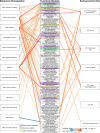Gut Feelings Begin in Childhood: the Gut Metagenome Correlates with Early Environment, Caregiving, and Behavior
- PMID: 31964729
- PMCID: PMC6974564
- DOI: 10.1128/mBio.02780-19
Gut Feelings Begin in Childhood: the Gut Metagenome Correlates with Early Environment, Caregiving, and Behavior
Abstract
Psychosocial environments impact normative behavioral development in children, increasing the risk of problem behaviors and psychiatric disorders across the life span. Converging evidence demonstrates that early normative development is affected by the gut microbiome, which itself can be altered by early psychosocial environments. However, much of our understanding of the gut microbiome's role in early development stems from nonhuman animal models and predominately focuses on the first years of life, during peri- and postnatal microbial colonization. As a first step to identify if these findings translate to humans and the extent to which these relationships are maintained after initial microbial colonization, we conducted a metagenomic investigation among a cross-sectional sample of early school-aged children with a range of adverse experiences and caregiver stressors and relationships. Our results indicate that the taxonomic and functional composition of the gut microbiome correlates with behavior during a critical period of child development. Furthermore, our analysis reveals that both socioeconomic risk exposure and child behaviors associate with the relative abundances of specific taxa (e.g., Bacteroides and Bifidobacterium species) as well as functional modules encoded in their genomes (e.g., monoamine metabolism) that have been linked to cognition and health. While we cannot infer causality within this study, these findings suggest that caregivers may moderate the gut microbiome's link to environment and behaviors beyond the first few years of life.IMPORTANCE Childhood is a formative period of behavioral and biological development that can be modified, for better or worse, by the psychosocial environment that is in part determined by caregivers. Not only do our own genes and the external environment influence such developmental trajectories, but the community of microbes living in, on, and around our bodies-the microbiome-plays an important role as well. By surveying the gut microbiomes of a cross-sectional cohort of early school-aged children with a range of psychosocial environments and subclinical mental health symptoms, we demonstrated that caregiving behaviors modified the child gut microbiome's association to socioeconomic risk and behavioral dysregulation.
Keywords: behavior; childhood; development; metagenomics; microbiome.
Copyright © 2020 Flannery et al.
Figures





References
-
- Fisher PA, Gunnar M. 2010. Early life stress as a risk factor for disease in adulthood, p 133–141. In Lanius RA, Vermetten E, Pain C (ed), The impact of early life trauma on health and disease. Cambridge University Press, Cambridge, United Kingdom: https://www.cambridge.org/core/product/identifier/9780511777042%23c88026....
Publication types
MeSH terms
Grants and funding
LinkOut - more resources
Full Text Sources
Medical
Research Materials
